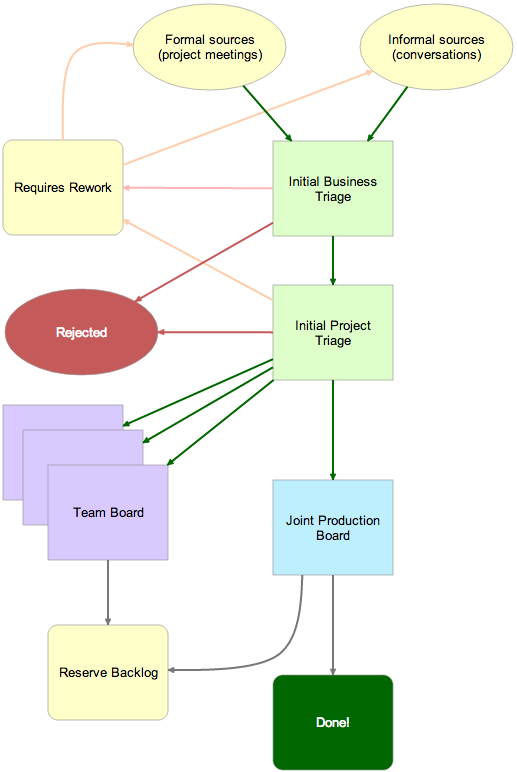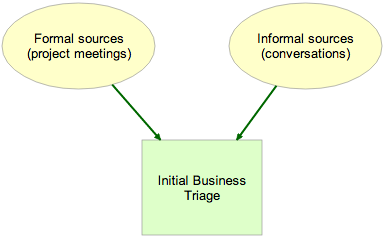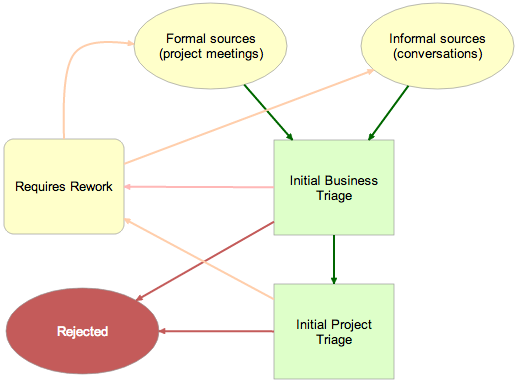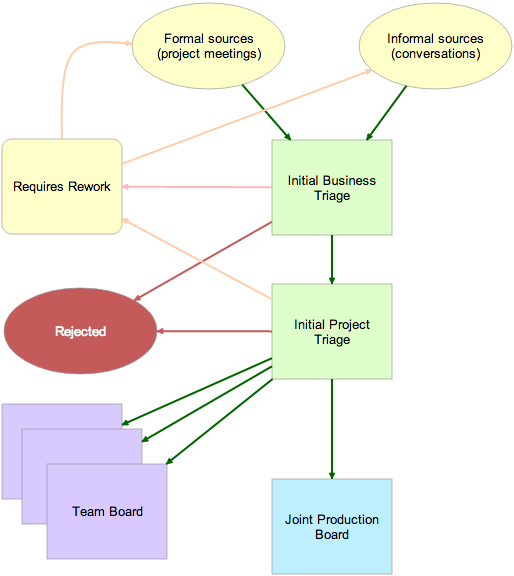We are often asked to advise our users on workflow: it isn’t a primary business of ours – we prefer to build partnerships with process consultants who can provide great services – but the insights we garner from these brief, often unofficial engagements do heavily influence our product design and roadmap planning.
Recently, we have been helping a large industrial company rethink it how it processes requests that come into its various engineering teams, and as a result reorganize its workflow so that there is optimal flow of work across its various design and engineering teams.
Background:
The company is based in North America, and operates on a 24×7 basis all year around, which isn’t unusual in industries that need continual production in order to fully utilize their very expensive equipment. As a result, their “distributed team challenge” was a little unusual: the teams weren’t distributed by location, but by time.
Every aspect of the companies design and engineering functions – which involved highly specialized teams – needed to be replicated in a day shift and a night shift so that work could be handed off continuously throughout the 24-hour cycle. And, that extended to weekends as well: some folks got a “regular weekend” (i.e. Saturday and Sunday off), while others got “staggered weekends” (e.g. Monday and Tuesday off).
Challenges:
In many respects, these teams had collaboration challenges that match those of a US-India distributed team, e.g. a team based on the US West Coast trying to collaborate with a team based in India, and having to deal with a 12.5-13.5 timezone difference (the variation comes from Daylight Savings Time, which isn’t observed in India.)
This 24×7 challenge was relatively straightforward: we have a lot of experience with helping US-India distributed teams work efficiently – based on our own experience, of course.
A different challenge had to do with streamlining the work of the multiple design and engineering teams involved: work requests were coming in from all directions, some through official channels like project planning meetings, and others through unofficial channels like hallway conversations, and in the absence of a clearly defined process to triage new requests, the various teams were feeling randomized.
All these requests were coming in, unfiltered and without any prior review, into a combined backlog that was being used by multiple teams, each of which would normally work independently, often in parallel with each other, and sometimes sequentially (serially) with each other.
Solution:
The solution we proposed was to create another Kerika board that sat upstream of the main engineering board.
This board was used to capture ideas and triage them, and ensure that only complete, appropriate requests made it to the main board’s backlog. This upstream board also helped divert single-team requests to other boards that were created for handling work items that were not cross-team or cross-functional.
The entire process was captured as a Kerika Whiteboard, as illustrated below:

Let’s take a look at this entire flow, piece by-piece:
At the top, we have requests coming in: formal requests initiated at project planning requests, and informal requests that originated in stray emails, unexpected hallway conversations, etc. All of these are captured as cards on a Planning Board organized with these columns:
New items :: Under Review :: Accepted by Business :: Accepted by Project :: Needs Rework :: Rejected
We recommended that a single person be designated as Business Owner, and tasked with doing the initial Business Triage of new cards:

The scope of Initial Business Triage is fairly limited: the Business Owner was asked to examine each new card, on a daily basis, and determine whether it qualified as Accepted by Business, Needs Rework, or Rejected.
Enough new ideas came into the organization that a daily review was recommended, and, importantly, the Business Owner was asked to move cards from New Items to Under Review so that people visiting the board at any time (of the day or night!) could see that their requests were in fact being worked on.
And, equally importantly, people could see the overall volume of requests coming into the organization, and adjust their expectations accordingly as to how promptly their own requests might be processed.
To further emphasize transparency and build support for the engineering teams, we recommended that the Planning Board include as many stakeholders as possible, added to the board as Visitors.
As noted above, the goal was to determine whether a card could be Accepted by Business or not, and for this the card needed:
- A sufficiently complete description for the work to be handed off to the engineering teams;
- To be within the plant’s overall scope and mission (as with most industrial companies, there were several large plants, each with a distinct mission);
- Have budget clearance.
This arrangement helped us achieve two important goals
- Encourage the promiscuous sharing of ideas, while simultaneously
- Ensuring new ideas met a minimum standard of completeness and relevance.
If an idea was within the organization’s scope/mission, but lacked sufficient detail or the appropriate budget approval, it was marked as Needs Rework. And if an idea was clearly outside scope, or had no chance of being funded, it was Rejected.
Another key consideration was to discourage people from setting Due Dates on cards early in the process: delaying the setting of deadlines, until the work reached the teams that would actually commit to delivery, helped preserve flexibility in scheduling and allocating resources.
Once the Business Owner did her initial triage of new work, cards were picked up by the designated Project Manager:

The Project Manager worked off the same Planning Board as the Business Owner; she picked up cards that were Accepted for Business. Her goal was to determine the likely impact of each work item, and, critically, to channel the work to either one of the single-team boards, or to the Joint Production board:

The Project Manager’s review focused not on business utility (since that was handled earlier by the Business Owner), but rather on identifying whether the work request was likely to affect a single team, or multiple teams.
If the work was likely to affect only a single team, the card was moved to that team’s Kerika board using a simple Cut-Paste operation.
If the work was likely to affect multiple teams, it was moved to the Joint Production Board, which was organized with these columns:
Backlog :: In Progress :: This Week :: Today :: Commission
Tags were used to identify the team involved; since the Joint Production Board typically had hundreds of cards at any point in time, and dozens of team members, this was essential for quick reviews by individual Team Members who wanted to filter out their team’s work items.
- As team members became available, they looked first to the Today column to see if anything was marked as Ready to Pull.
- If there was nothing in the Today column that was appropriate for the individual person’s skill sets, the person then looked to the This Week column for items that were Ready to Pull.
- As an item was taken up by an individual Team Member, she would put her face on the card, to signal to the rest of the team that she had taken ownership of the work.
- As work got done, the work product (design documents, engineering plans, etc.) were attached to the cards.
- As questions arose, or handoffs were made between team members or entire teams, Kerika’s integrated chat was used to communicate on the cards themselves. (And this is where the 24×7 operation really started to hum!)
Where appropriate Due Dates were set. We had noted earlier that we discouraged people from setting Due Dates at the time they requested new work, to preserve flexibility for the production teams; at this stage it was now appropriate for the teams to make date commitments.
Since all the work that reached the Joint Production Board involved multiple teams (by definition), the card details were updated to reflect the interim deadlines, e.g. the deadline for the Design Team to hand-off something to the Electrical Engineering team.
Once work was completed on a card, it was moved to the Commission column where the final deployment was handled. After that, the card would be moved to Done, and periodically (once a week) the Done column was swept off to another Project Archive board.
Occasionally, work would be shunted off to Reserve Backlog: this contained ideas and requests that were plausible or desirable in general terms, but had no realistic chance of being implemented in the short-term.

Key Lessons Learned
Some aspects of this workflow design should be of interest to teams in other industries and sectors:
- The use of a Planning Board to act as a way station for ideas and work requests, so that the main boards of the individual teams, as well as the Joint Production Board were not disrupted.
- The way station helped ensure that only complete work requests went on to the engineering boards.
- The way station encouraged people to contribute ideas and improve them before they were sent to engineering.
- Encouraging people to contribute ideas, by making the Planning Board open to a wide group of people who were given Team Member rights (i.e. the ability to add and modify cards).
- Separating the roles of Business Owner and Project Manager, so that the business evaluation was distinct from the implementation evaluation.
- Separation of individual team boards from the joint production board, so that single-team requests could get processed faster than they would have, if everything had gone through a single pipeline, on a single joint production board.
- The user of a Reserve Backlog, to hold on to ideas that the teams might wish to revisit in the future.
What do you think?
We would love to hear your thoughts on this case study!